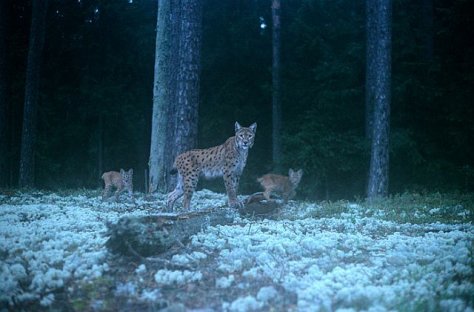Forest cat family
Photo: Sven Zacek, www.zacekfoto.ee
Translation: Liis
Family
Lynx; European lynx Ilves or harilik ilves Lynx lynx or Felis lynx
In a golden mushroom year hundreds of thousands of people move around in our forests. How many of them have met the lynx, the only feline animal of our forests?
The basis of our story is a summary of the telemetric study and observations of the activities of a female with young. She was equipped with a telemetric collar before the mating season.
The home territories of lynxes are quite large, up to 180 km2, but depending on the mode of life rhey are used differently; a female’s area of movement may even cover the home territory of a couple of males. When kittens are born to the female (cats have kittens!) at the end of May the female on foraging moved only in an area with a radius of a couple of kilometres around the nest with the suckling kittens and so it continued until the end of June (something happened in between that made the female move the kittens to a new nest place). Naturally the female also during that time caught prey only very moderately.
Since the beginning of July the family is no longer tied to the nest location. The location of the kittens was frequently changed (in intervals of 5 days) and was in the home forest of the female, one or a few kilometres away from the previous stopping place. The hunting area of the female increased during that time to 22 km2.
As the young groe and the need for food increased in August she already moved together with the offspring in a larger area and in September movements of the female lynx were registered on 70 km2. In October the family already used the whole home territory.
To cover the food need of the family now about 4 deer per month are needed (mostly young animals); of course the young lynxes are taught hunting. The start is wood mice, but less experienced foxes and raccoon dogs and other smaller predators move around on their own too – we have written about them earlier. The young of lynx become sexually mature at 2 years of age; the following year the family still lives led by the female. Of course they are taught hunting.
In 2012 there were only 72 lynx litters in Estonia according to the monitoring. The small increase in the number of roe deer in 2012 has not brought any improvement in the increase of lynxes. As the increase in number of predators follows that of the prey with some delay an increase in the number of lynxes can be expected only after some years. See LINK
Territorial behaviour and feeding habits of lynxes. Prepared by Raido Kont (in Estonian)









